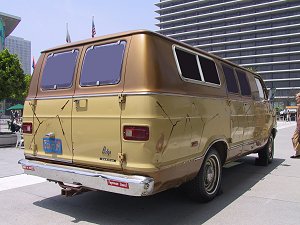 |
|
The Feynman van in front of the Mark Taper Forum for the play QED. Photos credit, Michael Kindig. |
The Feynman
Van
by Ralph Leighton
 |
|
The Feynman van in front of the Mark Taper Forum for the play QED. Photos credit, Michael Kindig. |
In 1975 Richard Feynman bought a new Dodge Tradesman Maxivan and had it outfitted in Long Beach according to the cultural mores of the times -- with a mustard-yellow, avocado-green interior, and a customized mural exterior.
He also obtained personalized license plates. Because a maximum of six letters were allowed at that time, Feynman settled for QANTUM. (Other possible combinations, such as QED and QUARK, had already been taken.)

During the summers of the late '70s, when son Carl was a teenager and daughter Michelle was around ten, the Feynman family took several trips in the vehicle, often camping out in remote random spots in the wilderness of the American West.
For several years the Feynman family also drove in the van to their beach house in Playa de la Mision, Baja California. Richard's mother, Lucille ("Beebee") Feynman, often made the trip as well.
A high point for the van was when Feynman drove it slowly down Colorado Boulevard in Pasadena during one of many "cruising nights," which were in vogue at the time.
Although Richard occasionally used the van to commute from his home in Altadena to Caltech, the van was usually driven by his wife, Gweneth. One time a perplexed motorist waiting at a red light asked the unidentified woman why she was driving a van with Feynman diagrams on the side. Her answer: "Because my name is Gweneth Feynman."
After Richard died, Gweneth Feynman sold the van for $1 (as was the Feynman custom for disposing of used cars) to Ralph Leighton, who later used it to transport visiting Tuvan throat-singers during their tour of California in 1993. (They had appeared in the Pasadena Tournament of Roses Parade as a living memorial to Feynman.) More recently, the van has been the object of mystery. (See "In Search of Feynman's Van.")
Although the van outfitter took some artistic liberty with the diagrams -- changing the angles at which the straight-line electrons and wavy-line photons are shown, in order to fit them onto the panels -- they are, for the most part, correct.

Of particular note is the diagram on the rear of the van: although it has the same shape as the diagram used in the play (which shows two electrons exchanging a photon), this diagram shows two muon neutrinos exchanging a particle that Feynman could only conjecture at the time. Years later, such a particle was proven to exist, and called a Z boson. Thus Feynman diagrams expanded their usefulness beyond QED to other areas of theoretical physics.